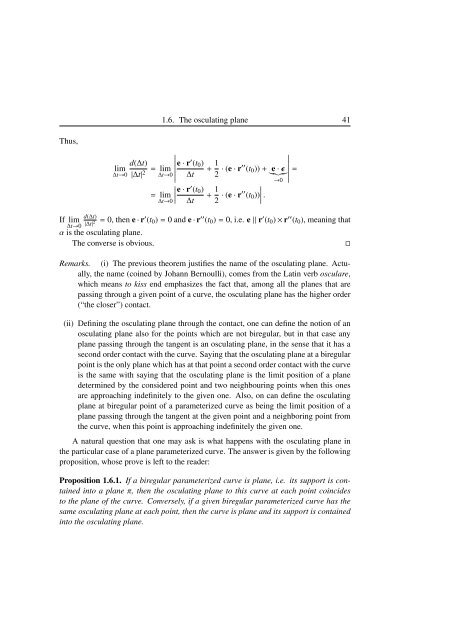Blaga P. Lectures on the differential geometry of - tiera.ru
Blaga P. Lectures on the differential geometry of - tiera.ru
Blaga P. Lectures on the differential geometry of - tiera.ru
You also want an ePaper? Increase the reach of your titles
YUMPU automatically turns print PDFs into web optimized ePapers that Google loves.
Thus,<br />
lim<br />
∆t→0<br />
d(∆t)<br />
= lim<br />
|∆t| 2 ∆t→0<br />
1.6. The osculating plane 41<br />
�<br />
�<br />
�<br />
�<br />
�<br />
e · r<br />
�<br />
�<br />
�<br />
′ (t0)<br />
∆t<br />
�<br />
�<br />
= lim<br />
�e<br />
· r<br />
�<br />
∆t→0 �<br />
′ (t0)<br />
∆t<br />
+ 1<br />
2 · (e · r′′ �<br />
�<br />
�<br />
�<br />
(t0)) + ���� e · ɛ �<br />
�<br />
�<br />
→0 � =<br />
+ 1<br />
2 · (e · r′′ �<br />
�<br />
(t0))<br />
�<br />
�<br />
� .<br />
d(∆t)<br />
If lim<br />
∆t→0 |∆t| 2 = 0, <strong>the</strong>n e · r ′ (t0) = 0 and e · r ′′ (t0) = 0, i.e. e � r ′ (t0) × r ′′ (t0), meaning that<br />
α is <strong>the</strong> osculating plane.<br />
The c<strong>on</strong>verse is obvious. �<br />
Remarks. (i) The previous <strong>the</strong>orem justifies <strong>the</strong> name <strong>of</strong> <strong>the</strong> osculating plane. Actually,<br />
<strong>the</strong> name (coined by Johann Bernoulli), comes from <strong>the</strong> Latin verb osculare,<br />
which means to kiss end emphasizes <strong>the</strong> fact that, am<strong>on</strong>g all <strong>the</strong> planes that are<br />
passing through a given point <strong>of</strong> a curve, <strong>the</strong> osculating plane has <strong>the</strong> higher order<br />
(“<strong>the</strong> closer”) c<strong>on</strong>tact.<br />
(ii) Defining <strong>the</strong> osculating plane through <strong>the</strong> c<strong>on</strong>tact, <strong>on</strong>e can define <strong>the</strong> noti<strong>on</strong> <strong>of</strong> an<br />
osculating plane also for <strong>the</strong> points which are not biregular, but in that case any<br />
plane passing through <strong>the</strong> tangent is an osculating plane, in <strong>the</strong> sense that it has a<br />
sec<strong>on</strong>d order c<strong>on</strong>tact with <strong>the</strong> curve. Saying that <strong>the</strong> osculating plane at a biregular<br />
point is <strong>the</strong> <strong>on</strong>ly plane which has at that point a sec<strong>on</strong>d order c<strong>on</strong>tact with <strong>the</strong> curve<br />
is <strong>the</strong> same with saying that <strong>the</strong> osculating plane is <strong>the</strong> limit positi<strong>on</strong> <strong>of</strong> a plane<br />
determined by <strong>the</strong> c<strong>on</strong>sidered point and two neighbouring points when this <strong>on</strong>es<br />
are approaching indefinitely to <strong>the</strong> given <strong>on</strong>e. Also, <strong>on</strong> can define <strong>the</strong> osculating<br />
plane at biregular point <strong>of</strong> a parameterized curve as being <strong>the</strong> limit positi<strong>on</strong> <strong>of</strong> a<br />
plane passing through <strong>the</strong> tangent at <strong>the</strong> given point and a neighboring point from<br />
<strong>the</strong> curve, when this point is approaching indefinitely <strong>the</strong> given <strong>on</strong>e.<br />
A natural questi<strong>on</strong> that <strong>on</strong>e may ask is what happens with <strong>the</strong> osculating plane in<br />
<strong>the</strong> particular case <strong>of</strong> a plane parameterized curve. The answer is given by <strong>the</strong> following<br />
propositi<strong>on</strong>, whose prove is left to <strong>the</strong> reader:<br />
Propositi<strong>on</strong> 1.6.1. If a biregular parameterized curve is plane, i.e. its support is c<strong>on</strong>tained<br />
into a plane π, <strong>the</strong>n <strong>the</strong> osculating plane to this curve at each point coincides<br />
to <strong>the</strong> plane <strong>of</strong> <strong>the</strong> curve. C<strong>on</strong>versely, if a given biregular parameterized curve has <strong>the</strong><br />
same osculating plane at each point, <strong>the</strong>n <strong>the</strong> curve is plane and its support is c<strong>on</strong>tained<br />
into <strong>the</strong> osculating plane.












